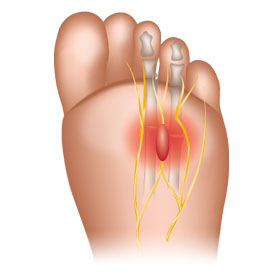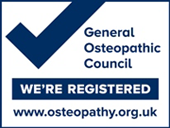Osteopathy & Morton’s neuroma – how much do you know?

What is it?
Morton’s Neuroma is a foot condition characterised by pain, localised swelling and inflammation of a nerve (the common digital nerve) usually around the ball of the foot between the 2nd & 3rd and/or the 3rd & 4th toes (metatarsal heads).
Causes
It is caused by abnormal function of the affected foot, leading to a compression of the nerve. Symptoms often occur if the patient has been putting significant pressure on the forefoot area whilst walking, standing, jumping and/or running. Morton’s neuroma can also be caused by constricting footwear such as high heels or shoes with pointy toes, leading to a pinching of the nerve between the metatarsal heads and the transverse inter-metatarsal ligament.
Symptoms
Symptoms of Morton’s neuroma are localised to the forefoot and toes. They include sharp pain, burning, tingling, cramping of the forefoot and/or localised numbness.
As the condition progresses, patients sometimes describe sensations of a palpable mass within the foot at the site of discomfort. Bending the toes is painful whilst walking, standing, jumping and/or running. Short-term relief is often reported when patients remove their footwear and massage the ball of the foot.
The condition affects females more than males and is reported by patients of all ages.
Diagnosis
Ultrasound scanning has been shown to accurately highlight the location and extent of Morton’s neuroma.
Differential Diagnosis
A range of other foot conditions may resemble Morton’s neuroma, including but not limited to:
- Metatarsal stress fracture (bony tenderness & pain upon palpation of the metatarsal shaft)
- Metatarsophalangeal joint synovitis (painful during active / passive join motion)
- Inter-metatarsal bursitis
- Extensor tendon tenosynovitis
- Tumour
Treatment
A range of treatment options exist for Morten’s neuroma:
- The use of foot orthotics with appropriate padding to deflect pressure from the forefoot and nerve.
- Local steroid / painkiller injection to reduce inflammation.
- Chronic or unresponsive cases may require minor surgery to deal with the affected part of the nerve.
- Wearing good quality trainers for suitable motion control.
- Osteopathic treatment involves advice on short-term management (rest, ice, compression and elevation of the affected foot) and manual therapy to reduce local inflammation and increase the function of the forefeet and affected areas higher up in the chain (e.g. hips, knees and lower back).
Contact Woburn Osteopaths today for detailed advice and treatment for Morton’s neuroma: 01525 290615.


